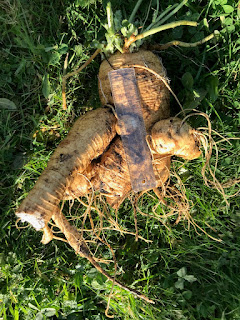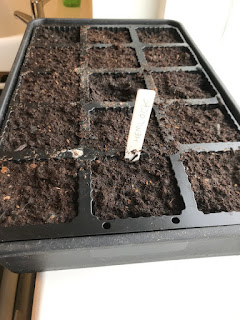Wartime home grown anaesthetics. Part 1: Spring
Wars can bring out the worst in human nature and result in indiscriminate violence, property destruction and large scale suffering, such as we are currently witnessing on our television screens night after night. They can also foster great resilience and ingenuity in overcoming obstacles. In this post I am going to look at how our wartime ancestors in Britain circumvented the German blockade of vital medicines during two world wars and re-learned how to gather or grow medicines at home. And as part of this, I am going to grow some of these plants myself and record their progress throughout this year.
At the start of the 20th century, many of Britain’s pharmaceuticals came from Germany, but during WWI and WWII, this source of supply was unavailable, and alternative sources from elsewhere in the British Empire could not be relied upon because of enemy blockades of shipping. However, anaesthetics, painkillers and other essential drugs were needed in large quantities to treat both civilians and wounded soldiers.
Collecting or cultivating medicinal plants became a cottage industry in which anyone could participate. Children were sent out into the countryside to gather rose hips and conkers while farmers were given advice on how to grow medicinal crops in pamphlets such as this one from the Ministry of Agriculture and Fisheries (1942):
In the inter-war years, American farmers were also encouraged to turn their hand to cultivating “drug plants”:
A concise history of the wartime use of medicinal plants can be found in this excellent book “Britain’s Green Allies” by Peter Ayres (sadly now out of print):
All of the plants described below have been collected or cultivated in wartime, or have a long history of use as painkillers or anaesthetics, in some cases going back thousands of years. Please remember that they are all toxic if used improperly, you cultivate them at your own risk, and they should be kept away from children. They are all shown growing in the cool, temperate climate of the Isle of Man, British Isles. You may find it easier or harder to grow them in your area, depending on your local climatic conditions.
There is a significant degree of overlap between these plants and the so-called witches’ herbs used in medieval times. However, there is very little overlap between these plants and mainstream herbal medicines as they are so toxic.
Henbane (Hyoscyamus niger)
Henbane grows wild in the British Isles although prefers the warmer southern parts. Easily cultivated. Induces a trance-like state, used in anaesthetics since the ancient Greek civilisation. I have starting these plants off in modular seed trays and they appear to be doing well.
Jimsonweed / Thornapple (Datura stramonium)
Like Henbane, Thornapple induces a trance-like state. Originated in Central America, has a reputation as an aggressive invasive weed in warm climates, but does not do well in cooler climates. It needs room temperature (around 20 degrees Celsius) to germinate, fertile soil, plenty of room for the roots, a fairly long growing season, and it is irresistible to slugs, which will eat it in preference to almost anything else in the garden. For those reasons it has never become naturalised in the British Isles, although sporadic specimens have been found, probably originating from imported birdseed.
As you can see from the photograph, there is not much action going on in the Thornapple pots, probably because these seeds take 2-3 weeks to germinate and I only started them off about 2 weeks ago. The pot has a copper band around the base to deter slugs. Apparently there is a reaction between slug slime and copper which slugs find unpleasant.
White bryony / English mandrake (Bryonia alba)
White bryony induces a trance-like state similar to Henbane and Jimsonweed. A climbing vine, native to the British Isles, where it is often found in hedgerows. It grows vigorously, 10 feet or more in a season, and tends to invade the neighbours’ garden. The seed is distributed by birds, but it can probably also be propagated by dividing the large turnip-like root. Needs a fence to climb up. The root can be used as a substitute for Mediterranean mandrake, which does not grow well here.
This photograph shows the large turnip-like root, dug up for inspection and replanting last autumn:
This photograph shows the same root, planted and starting to grow:
Opium poppy (Papaver somniferum)
Opium poppies have been used for pain relief for thousands of years. The sap contains opiate alkaloids such as morphine and codeine. Legal status varies from one country to another. In the British Isles it is legal to grow as an ornamental plant but not to extract opiate alkaloids from it. In Canada, cultivation even for ornamental purposes is prohibited. In the United States its legal status is ambiguous.
Poppies grow well in the British climate and are a common cornfield weed. The seeds can remain dormant in the soil for decades until exposed to the right conditions for germination. The usual gardening advice is to sow the seeds in early spring, but I have found that in the Isle of Man climate, this often seems to be too late and the seedlings are vulnerable to drought. Sowing in autumn or winter seems to work better.
This photograph shows opium poppy seed heads from poppies planted on Douglas Promenade, Isle of Man by Douglas Corporation. The brown staining showing through the capsule is the opium:
Mediterranean / European mandrake (Mandragora officinarum)
Viewers of the British-American horror drama “The Terror”, about Captain Sir John Franklin's lost expedition to the Arctic in 1845–1848, may remember that “Mandragora” was mentioned as one of the contents of the ship’s medicine chest. The anaesthetic of choice of the ancient Romans was a combination of opium (for pain relief) and Mediterranean mandrake root (to induce unconsciousness). However, it is native to the Mediterranean region and does not do well in the British climate, making white bryony (above) a more practical choice.
This mandrake plant is growing from a root purchased last year. It appears to be vulnerable to slug attack and is frost-sensitive, so I will not plant it out in the garden until late May:
Hemlock (Conium maculatum)
Hemlock is highly toxic and was used to execute prisoners in ancient Greece, including Socrates. Causes temporary muscle paralysis, which can be fatal if it paralyses the breathing muscles and there are no facilities for immediate artificial ventilation. Native to Europe and North Africa but has become naturalised in parts of the British Isles.
Not much action going on in the Hemlock seed tray so far:
Monkshood / Wolfsbane (Aconitum spp)
Wolfsbane is also highly toxic, with a mode of action similar to hemlock (above). Causes paralysis of respiratory muscles and cardiac arrhythmias. Native to mountain meadows in the northern hemisphere but naturalised in the British Isles. The name “monkshood” refers to the shape of the flower, and “wolfsbane” may refer to the fact that it was used in poisoned bait or arrows to kill wolves.
This plant is doing well and is about ready to be planted out:
Deadly nightshade (Atropa belladonna)
Belladonna is also a highly toxic nerve agent, with a similar mode of action to hemlock and monkshood. Used as a biological weapon since Roman times; invading Roman armies used to poison wells with it as part of a “scorched earth” campaign. Native to the British Isles, preferring calcareous (chalky) soils; wartime Government advice to farmers cultivating it was to lime the field heavily. The name “belladonna” means “beautiful lady” in Italian, and probably refers to its use as a cosmetic to increase pupil size by temporarily paralysing the nerves controlling the pupil.
Belladonna has a fearsome reputation as one of Britain’s most poisonous (to humans and dogs) native plants, but farm animals, rabbits, insects, slugs and some birds can all eat the plant with apparently no ill effects. It is quite vulnerable to drought and slug attack and is uncommon in the wild. The photograph shows a young Belladonna plant just awakening from its winter dormancy, in a pot protected by a copper slug-repellant band. I will plant it out in a couple of months.
I’ll give you a progress report on all of these plants in June.
Slaynt vie, bea veayn, beeal fliugh as baase ayns Mannin














.jpg)


Thanks a lot for these regular posts. And for the digitalized manual. I contacted you three years ago ( Irish GP in the West of Ireland here) about your post collapse guide. I’m now retired. I have grown my veg for 25 years in this windswept beautiful Connemara. I have also grown medicinal herbs for the last 10 years. They are very useful for family and neighbors. I am getting used to do without pharmaceutical products. I am going to start some toxic plants this year due to the remoteness of my location. I am taking notes from your posts. Did you find it easy to find seeds and roots for them ?
ReplyDelete